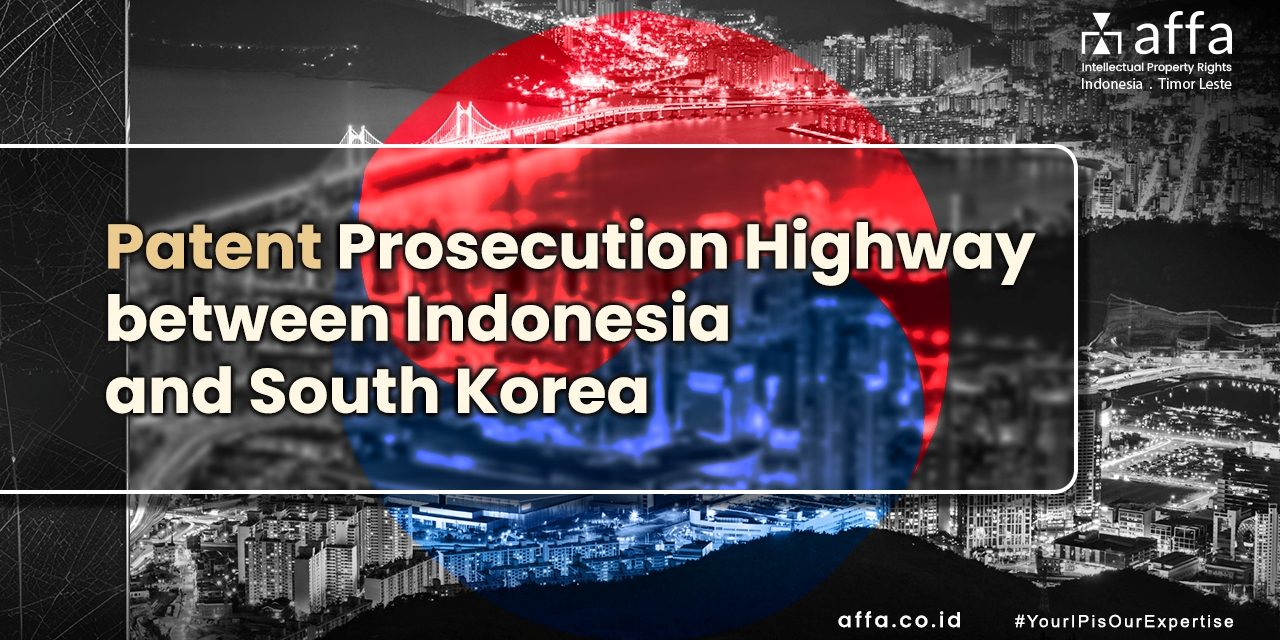Patent Prosecution Highway between Indonesia and South Korea
Starting this December, the Indonesian Patent Office (DGIP) and the Korean Intellectual Property Office (KIPO) began implementing the Patent Prosecution Highway (PPH) program. This program aims to ensure that South Korean companies entering Indonesia can obtain Patent Examinations more quickly, from 40 months to just 18.4 months.
This KIPO PPH collaboration with DGIP is the 10th Bilateral PPH after previously collaborating with IMPI (Mexico – July 1, 2012), IPOPHL (Philippines – May 1, 2015), TIPO (Taiwan – July 1, 2015), EAPO (Eurasia Patent Office – January 1, 2019), IPVN (Viet Nam – June 1, 2019), SAIP (Saudi Arabia – July 1, 2019), INPI (Brazil – April 1, 2020), and MyIPO (Malaysia – December 1, 2020 ), INPI (France – September 1, 2022). It is called Bilateral PPH because it is still a pilot program, before finally becoming Global PPH, as has been implemented in IP5 countries (China, Japan, USA, & EU) and other 24 countries, such as the UK, Singapore, Australia, and Russia.
The Basic Concept PPH
Where an Office of First Filing (OFF) has assessed the patentability of a Patent Application, an Office of Second Filing (OSF) offers the Applicant accelerated examination for the corresponding Application, provided that certain conditions are met. Those conditions include sufficient correspondence in the claims of the two applications and the search and examination results of an OFF being made available to an OSF.
Under the PPH program, the examination results of an OFF are used to expedite the application process in an OSF, thereby reducing the workload and improving patent quality. If deemed patentable by an OFF, the corresponding application is filed in advance for accelerated examination in an OSF.
This PPH program is divided into two categories: PPH using the National Work Products and PPH using the PCT International Products from the KIPO. The following are the procedures for each category:
1. PPH using the National Work Products from the KIPO
Applicants can request accelerated examination by a prescribed procedure including submission of relevant documents on an application filed with the DGIP and satisfies the following requirements under the DGIP-KIPO Patent Prosecution Highway (PPH) pilot program based on the KIPO application.
When filing a request for the PPH pilot program, an applicant must submit a request form to the DGIP.
The offices may terminate the PPH pilot program if the volume of participation exceeds a manageable level, or for any other reason. Ex Ante notice will be published if the PPH pilot program is terminated.
The PPH pilot program will be in effect for three (3) years commencing on 8 December 2023 and will end on 8 November 2026. However, the program may be extended after a joint DGIP – KIPO review and assessment of the program implementation.
- Requirements
a. Both the DGIP application on which PPH is requested and the KIPO application(s) forming the basis of the PPH request shall have the same earliest date (whether a priority date or a filing date).
For example, the DGIP application (including the PCT national phase application) may be either:
-
-
-
- an application that validly claims priority under the Paris Convention from the KIPO application(s) except for a complex priority.
-
-
Example:
A. Paris Route

B. PCT Route

C. PCT Route – Domestic Priority

D. Paris Route – Complex Priority
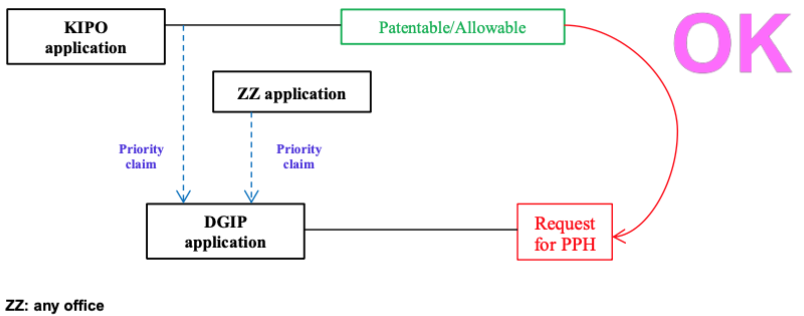
E. Paris Route – Divisional Application
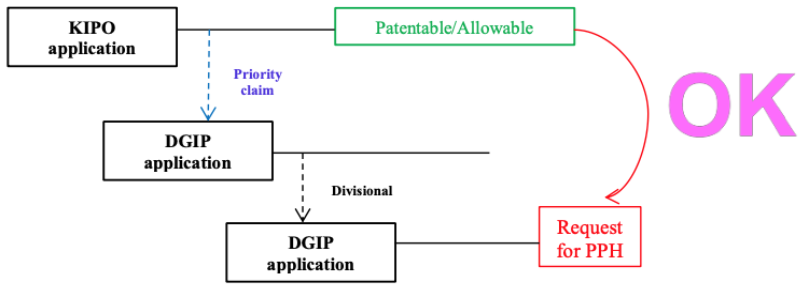 F. PCT ROUTE
F. PCT ROUTE

-
-
-
- an application that provides the basis of a valid priority claim under the Paris Convention for the KIPO application(s) (including PCT national phase application(s)).
-
-
Example:
A. Paris Route
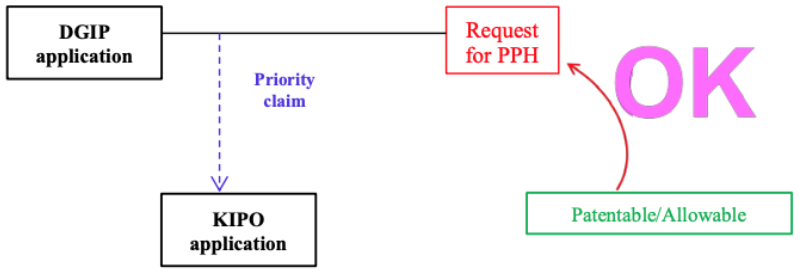
B. PCT Route
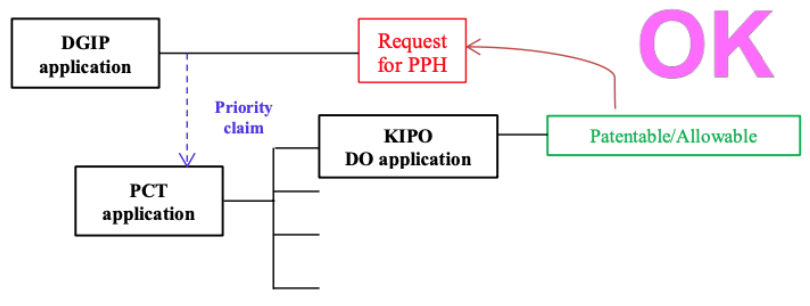
-
-
-
- a PCT national phase application where both the DGIP application and the KIPO application(s) are derived from a common PCT international application having no priority claim.
-
-
Example:
A. Direct PCT Route

B. Direct PCT & Paris Route

C. Direct PCT & PCT Route
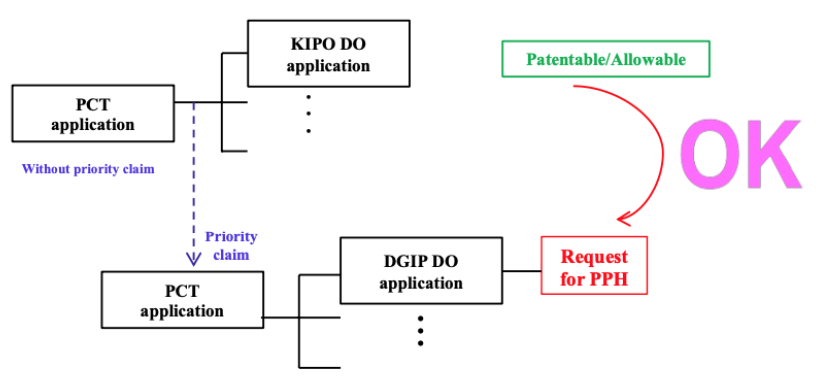
D. Direct PCT & PCT Route
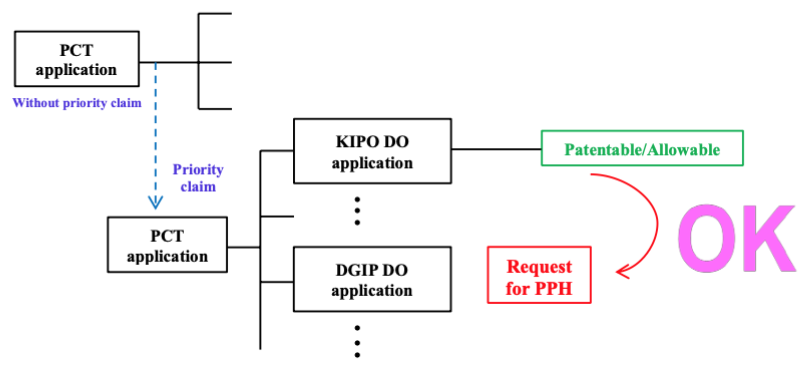
b. Patent applications have been initiated in the Office of the KIPO or the DGIP.
Patent applications belong to a patent family of which at least the earliest application was filed with the DGIP or the KIPO acting as a national office. The DGIP application which validly claims priority direct PCT applications is also eligible.
Example:
A. Paris Route BUT the First Application is from the Third Country
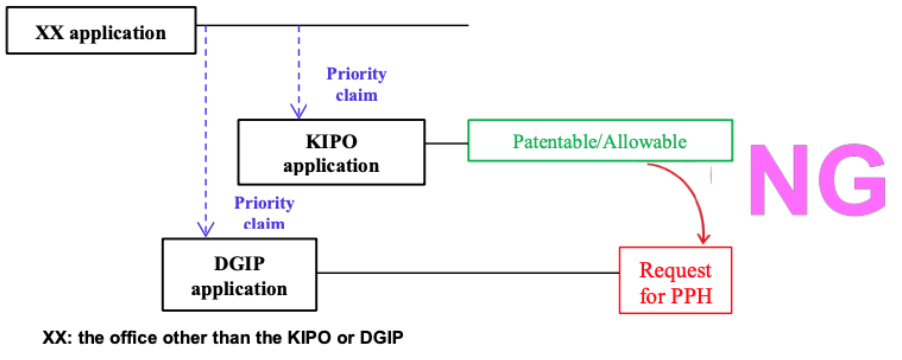
B. PCT Route BUT the First Application is from the Third Country

c. At least one corresponding application exists in the KIPO and has one or more claims that are determined to be patentable/allowable by the KIPO.
The corresponding application(s) can be the application that forms the basis of the priority claim, an application derived from the KIPO application that forms the basis of the priority claim (e.g., a divisional application of the KIPO application or an application that claims domestic priority to the KIPO application, example:
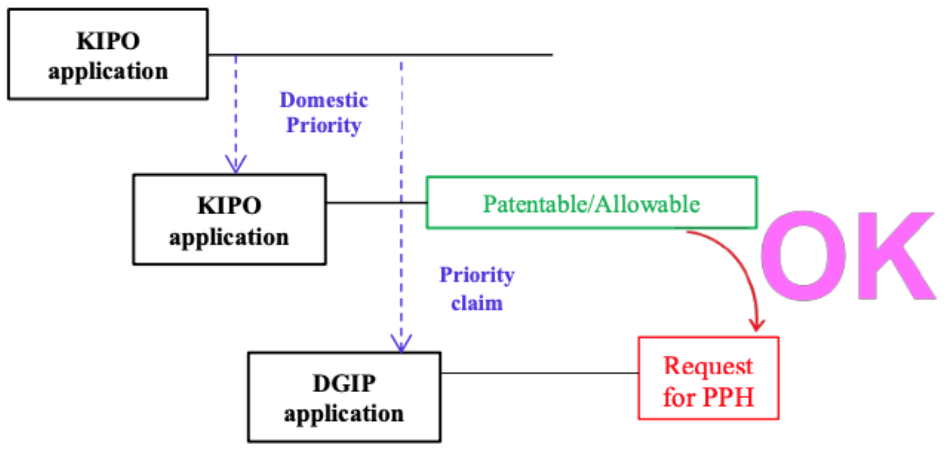
or a KIPO national phase application of a PCT application.
Example:
A. PCT Route

B. Direct PCT Route

C. Direct PCT & PCT Route
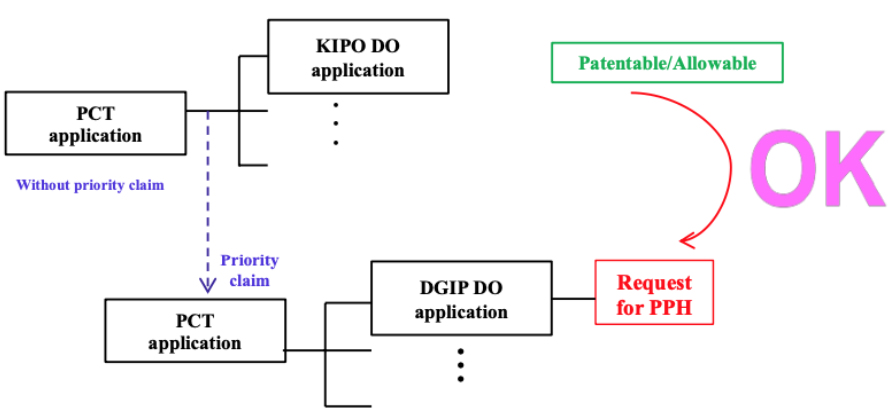
D. Direct PCT & PCT Route
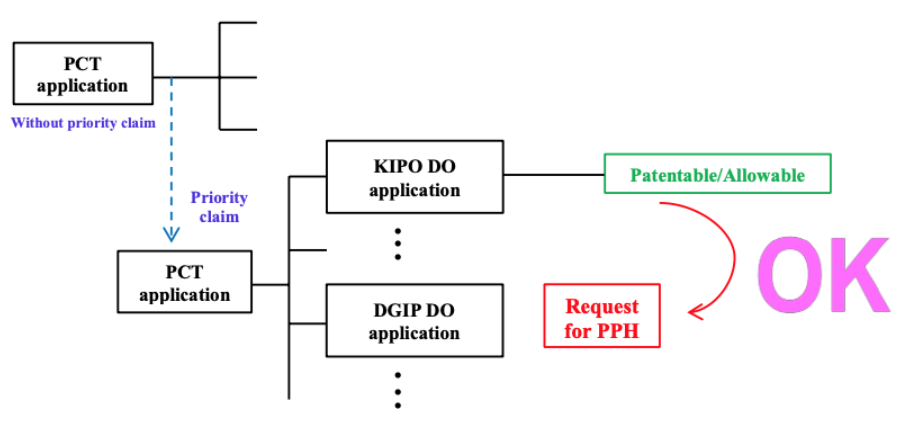
Claims are “determined to be patentable/allowable” when the KIPO examiner identifies the claims as patentable/allowable in the latest office action, even if the application is not granted for patent. The office’s action includes:
-
-
-
-
- Decision to Grant a Patent
- Notification of Reasons for Refusal
- Decision of Refusal
- Appeal Decision
-
-
-
For example, if the following routine expression is described in the “Notification of Reason for Refusal” of the KIPO, those claims are clearly identified to be patentable/allowable.
“<Claims which has been found no reason for refusal>
At present for an invention concerning Claim, no reason for refusal is found.”
d. All claims on file, as originally filed or as amended, for examination under the PPH must sufficiently correspond to one or more of those claims indicated as patentable/allowable in the KIPO.
Claims are considered to “sufficiently correspond” where, accounting for differences due to translations and claim format, the claims in the DGIP are of the same or similar scope as the claims in the KIPO, or the claims in the DGIP are narrower in scope than the claims in the KIPO.
In this regard, a claim that is narrower in scope occurs when a KIPO claim is amended to be further limited by an additional feature that is supported in the specification (description and/or claims).
A claim in the DGIP that introduces a new/different category of claims to those claims indicated as allowable in the KIPO is not considered to sufficiently correspond.
For example, where the KIPO claims only contain claims to a process of manufacturing a product, then the claims in the DGIP are not considered to sufficiently correspond if the DGIP claims introduce product claims that are dependent on the corresponding process claims.
Any claims amended or added after the grant of the request for participation in the PPH pilot program need not sufficiently correspond to the claims indicated as patentable/allowable in the KIPO application.
e. The DGIP has not begun an examination of the application at the time of request for the PPH.
Example:
-
-
- Examination has begun before a request for PPH
-
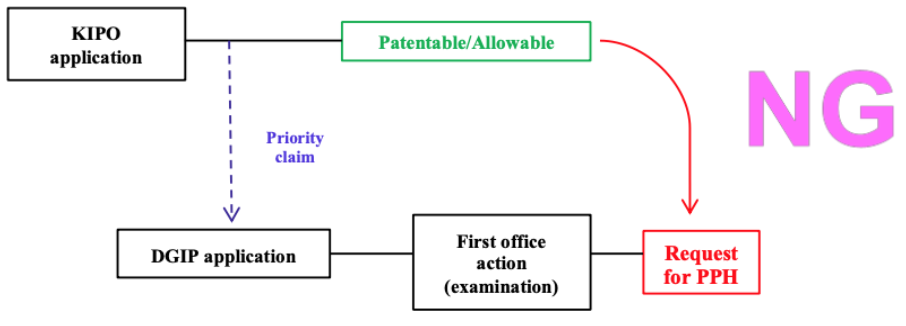
-
-
- The application has not been published at the time of request for PPH
-

f. The first office action has not been issued at the time of request for the PPH.
Example:
-
-
- The application has received the first office action at the time of request for PPH
-

-
-
- PPH request simultaneously with the Request for Substantive Examination
-

- Documents to be Submitted
Documents (a) to (d) below must be submitted by attaching to the PPH request.
a. Copies of all office actions (which are relevant to substantial examination for patentability in the KIPO) which were issued for the corresponding application by the KIPO, and translations of them.
Either Indonesian or English is acceptable as a translation language. The applicant does not have to submit a copy of KIPO office actions and translations of them when those documents are provided via KIPO’s dossier access system (K-PION), because the office actions and their machine translations are available for the DGIP examiner via the KIPO’s dossier access system. If they cannot be obtained by the DGIP examiner via the dossier access system, the applicant may be notified and requested to provide the necessary documents.
b. Copies of all claims determined to be patentable/allowable by the KIPO, and translations of them.
Either Indonesian or English is acceptable as a translation language. The applicant does not have to submit a copy of claims indicated to be patentable/allowable in the KIPO, and translations thereof when the documents are provided via KIPO’s dossier access system because they are available for the DGIP examiner via the KIPO’s dossier access system. If they cannot be obtained by the DGIP examiner via the KIPO’s dossier access system, the applicant may be notified and requested to provide the necessary documents.
c. Copies of references cited by the KIPO examiner
If the references are patent documents, the applicant doesn’t have to submit them because the DGIP usually possesses them. When the DGIP does not possess the patent document, the applicant has to submit the patent document at the examiner’s request. Non-patent literature must always be submitted. The translations of the references are unnecessary.
d. Claim correspondence table
The applicant requesting PPH must submit a claim correspondence table, which indicates how all claims in the DGIP application sufficiently correspond to the patentable/allowable claims in the KIPO application.
When claims are just literal translations, the applicant can just write down that “they are the same” in the table. When claims are not just literal translations, it is necessary to explain the sufficient correspondence of each claim. When the applicant has already submitted the above documents (a) to (d) to the DGIP through simultaneous or past procedures, the applicant may incorporate the documents by reference and does not have to attach them.
2. PPH using the PCT International Work Products from the KIPO
Applicants can request accelerated examination by a prescribed procedure including submission of relevant documents on an application that is filed with the DGIP and satisfies the following requirements under the DGIP-KIPO Patent Prosecution Highway pilot program based on PCT international work products (PCT-PPH pilot program).
When filing a request for the PCT-PPH pilot program, an applicant must submit a request form to the DGIP.
The Offices may terminate the PCT-PPH pilot program if the volume of participation exceeds a manageable level, or for any other reason. Ex Ante notice will be published if the PPH pilot program is terminated.
The PPH pilot program will be in effect for three (3) years commencing on December 8, 2023, and will end on November 8, 2026. However, the program may be extended after a joint DGIP- KIPO review and assessment of the program implementation.
- Requirements
The application which is filed with the DGIP and on which the applicant files a request under the PCT-PPH must satisfy the following requirements:
1. The latest work product in the international phase of a PCT application corresponding to the application (“international work product”), namely the Written Opinion of International Search Authority (WO/ISA), the Written Opinion of International Preliminary Examination Authority (WO/IPEA) or the International Preliminary Examination Report (IPER), indicates at least one claim as patentable/allowable (from the aspect of novelty, inventive steps and industrial applicability).
Note that the ISA and the IPEA which produced the WO/ISA, WO/IPEA, and the IPER are limited to the KIPO, but, if priority is claimed, the priority claim can be based on an application in any Office. Example:
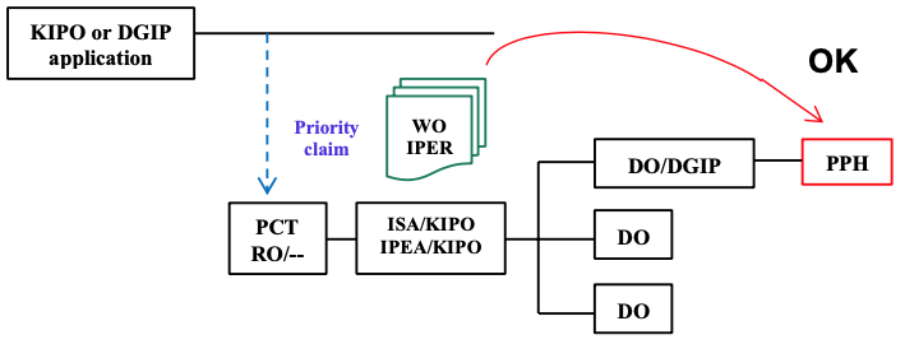
The applicant cannot file a request under PCT-PPH based on an International Search Report (ISR) only.
In case any observation is described in Box VIII of WO/ISA, WO/IPEA, or IPER which forms the basis of a PCT-PPH request, the applicant must explain why the claim(s) is/are not subject to the observation irrespective of whether or not an amendment is submitted to correct the observation noted in Box VIII. The application will not be eligible for participating in the PCT-PPH pilot program if the applicant does not explain why the claim(s) is/are not subject to observation. In this regard, however, it does not affect the decision on the eligibility of the application whether the explanation is adequate and/or whether the amendment submitted overcomes the observation noted in Box VIII.
2. The DGIP application and the corresponding international application shall have the same earliest date (whether a priority date or a filing date).
For example, the DGIP application may be either:
a. a national phase application of the corresponding international application. Example:
-
-
-
- The application is a national phase application of the corresponding international application.
-
-
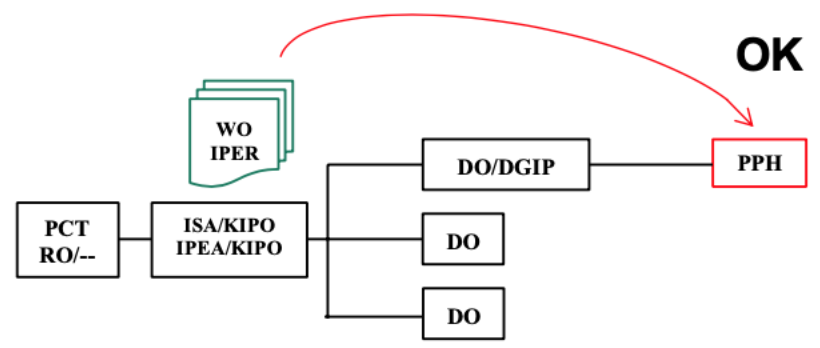
-
-
-
- The application is a national phase application of the corresponding international application. (The corresponding international claims priority from KIPO or DGIP application.)
-
-
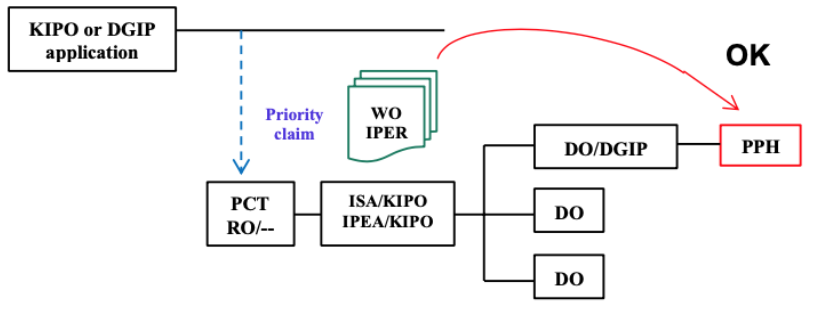
b. a national application as a basis of the priority claim of the corresponding international application. Example:

c. a national phase application of an international application claiming priority from the corresponding international application. Example:
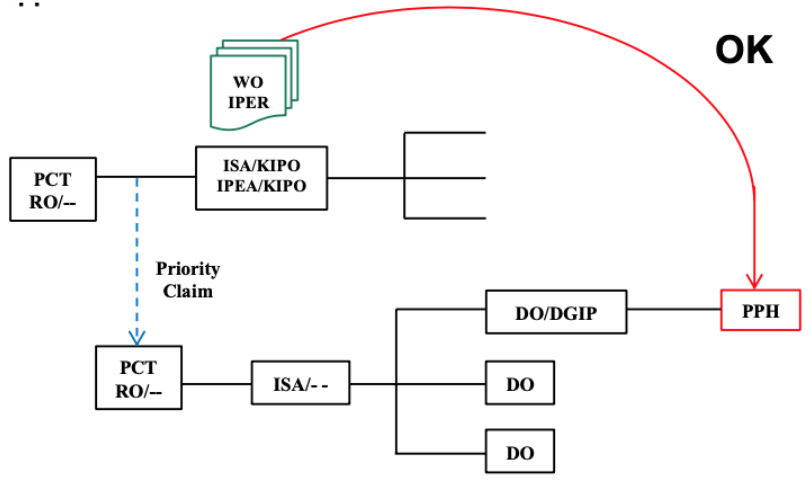
d. a national application claiming foreign priority from the corresponding international application. Example:

e. a derivative application (divisional application and application claiming domestic priority etc.) of an application that satisfies one of the above requirements (a to d). Example:
-
-
-
- The application is a divisional application of an application that satisfies the requirement (a) above.
-
-

-
-
-
- The application is an application claiming domestic priority from DGIP application which satisfies the requirement (b) above.
-
-
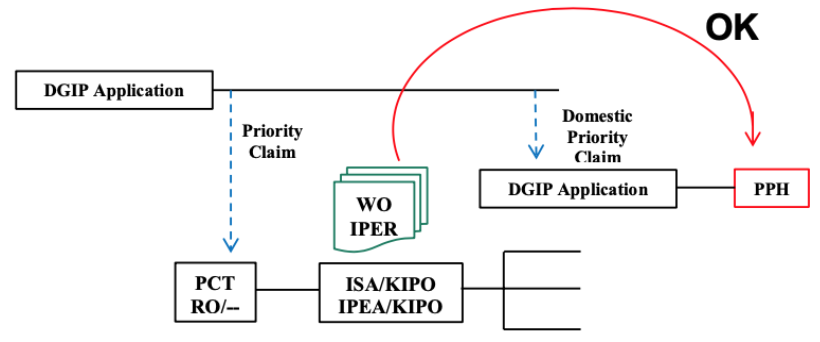
3. Patent applications have been initiated in the Office of the KIPO or the DGIP.
Patent applications belong to a patent family of which at least the earliest application was filed with the KIPO or the DGIP acting as a national office. The DGIP application which validly claims priority to direct PCT applications is also eligible.
4. All claims on file, as originally filed or as amended, for examination under the PCT- PPH must sufficiently correspond to one or more of those claims indicated as allowable in the latest international work product of the corresponding international application.
Claims are considered to “sufficiently correspond” where accounting for differences due to translations and claim format, the claims in the DGIP are of the same or similar scope as the claims indicated as allowable in the latest international work product, or the claims in the DGIPare narrower in scope than the claims indicated as allowable in the latest international workproduct.
In this regard, a claim that is narrower in scope occurs when a claim indicated as allowable in the latest international work product is amended to be further limited by an additional feature that is supported in the specification (description and/or claims).
A claim in the DGIP that introduces a new/different category of claims to those claims indicated as allowable in the latest international work product is not considered to sufficiently correspond. For example, where the claims indicated as allowable in the latest international work product only contain claims to a process of manufacturing a product, then the claims in the DGIP are not considered to sufficiently correspond if the DGIP claims introduce product claims that are dependent on the corresponding process claims.
Any claims amended or added after the grant of the request for participation in the PCT- PPH pilot program need not sufficiently correspond to the claims indicated as allowable in the latest international work product.
5. The DGIP has not begun examination of the application at the time of request for the PCT-PPH.
6. The first office action has not been issued at the time of request for the PPH.
- Documents to be Submitted
The applicant must submit the following documents attached to the request form in filing a request under PCT-PPH. Some of the documents may not be required to be submitted in certain cases.
1. A copy of the latest international work product that indicates the claims to be patentable/allowable and their Indonesian or English translations if they are not in English.
In case the application satisfies the relationship 1.(2)(a), the applicant need not submit a copy of the International Preliminary Report on Patentability (IPRP) and any English translations thereof because a copy of these documents is already contained in the file- wrapper of the application. In addition, if a copy of the latest international work product and a copy of the translation is available via “PATENTSCOPE (registered trademark)”, an applicant need not submit these documents, unless otherwise requested by the DGIP. (WO/ISA and IPER are usually available as “IPRP Chapter I” and “IPRP Chapter II” respectively 30 months after the priority date.)
2. A copy of a set of claims in which the latest international work product of the corresponding international application is indicated to be patentable/allowable and their Indonesian or English translations if they are not in English.
If the copy of the set of claims that are indicated to be patentable/allowable is available via “PATENTSCOPE (registered trademark)” (e.g. the International Patent Gazette has been published), an applicant need not submit this document unless otherwise requested by the DGIP. Where the set of claims is written in the Korean language, the translations thereof must be still submitted by an applicant.
3. A copy of references cited in the latest international work product of the international application corresponding to the application.
If the reference is a patent document, the applicant is not required to submit it. In case the DGIP has difficulty in obtaining the document, however, the applicant may be asked to submit it. Non-patent literature must always be submitted. Translations of cited references are unnecessary.
4. A claims correspondence table that indicates how all claims in the application sufficiently correspond to the claims indicated to be patentable/allowable.
When claims are just literal translations, the applicant can just write down that “they are the same” in the table. When claims are not just literal translations, it is necessary to explain the sufficient correspondence of each claim based on the criteria 1. (4) (Please refer to the Example form below).
When an applicant has already submitted the above-mentioned documents (1) – (4) to the DGIP through simultaneous or past procedures, the applicant may incorporate the documents by reference and is thus not required to attach the documents.
If you need further information on how to apply for PPH in Indonesia, please don’t hesitate to contact us via [email protected].
Source:
- Detik News
- KBS World Indonesian
- Korean Intellectual Property Office
- Directorate General Intellectual Property

